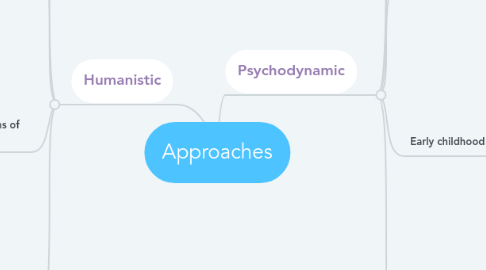
1. Humanistic
1.1. humans are self-determining and have free will, we act as active agents
1.2. Maslow - self actualisation
1.2.1. we all have an innate tendency to fulfill all our needs
1.2.1.1. reaching self actualisation means you have fully became what you're capable of
1.2.2. heirarchy of needs
1.2.2.1. physiological - breathing, food, water, sex
1.2.2.2. need for safety - security of employment, family, health etc
1.2.2.3. need for love/belonging - friendship, family, intimacy
1.2.2.4. need for esteem - confidence, dignity, strength
1.2.2.5. self actualisation - morality, creativity, acceptance
1.2.2.5.1. all needs on the lower tiers must be fulfilled before someone can reach self actualisation
1.3. Rogers - self, congruence and conditions of worth
1.3.1. the self must have congruence with the ideal self
1.3.2. if they dont reach the ideal self, then you may experience negative feelings
1.3.3. client-centred therapy, helps to reduce the gap between self and ideal self
1.3.3.1. many problems that adults face are due to having conditions of worth being placed upon them when they were a child e.g. i will only love you if....
1.4. Evaluation
1.4.1. strengths
1.4.1.1. not reductionist - advocates holism, that the whole person must be taken into account
1.4.1.2. positive approach - everyone has the potential to achieve their goals
1.4.2. weaknesses
1.4.2.1. limited application - lacks evidence and is described as abstract concepts
1.4.2.2. cultural bias - can't be applied to collectivist cultures as they focus on the needs of the whole group not each individual
2. Psychodynamic
2.1. Role of the unconscious
2.1.1. Conscious - mental activity that we're aware of
2.1.2. Preconscious - can become aware of them if we want to
2.1.3. Unconscious - deep memories/instincts that we aren't aware of
2.1.4. Psychic determinism - unconscious forces and drives are inborn and control or determine behaviour, all we say or do has a cause
2.2. Structure of personality
2.2.1. The Id - in the unconscious, primary focus to satisfy needs, operates on the pleasure principle
2.2.2. The Ego - the executive of the personality, balances its desires, operates on the reality principle
2.2.2.1. must balance the needs of the id and superego, otherwise it could result in conflict and psychological disorders
2.2.3. The Superego - in the conscience, opposes the desires of the id, insists that we do the right thing
2.3. Defence mechanisms
2.3.1. repression - forcing a distressed memory out of the conscious
2.3.2. denial - refusing to acknowledge aspects of reality because they're too painful
2.3.3. displacement - transferring feelings into a substitute target
2.4. Early childhood experiences
2.4.1. events in our childhood will effect us in the future, we all go through the same 5 stages of development
2.4.1.1. Oral - pleasure from mouth and mothers breast
2.4.1.1.1. oral fixations e.g. smoking, biting nails, critical, sarcastic
2.4.1.2. Anal - pleasure from anus and withholding/expelling faeces
2.4.1.2.1. retentive - perfectionist, obsessive
2.4.1.3. Phallic - pleasure from genital area
2.4.1.3.1. personality e.g. reckless, narcissistic, possibly homosexual
2.4.1.4. Latency - conflicts arerepressed
2.4.1.4.1. no consequences
2.4.1.5. Genital - sexual desires become conscious, also puberty
2.4.1.5.1. difficulty forming heterosexual relationships
2.5. Evaluation
2.5.1. strengths
2.5.1.1. importance of unconscious factors
2.5.1.2. important influence of childhood experiences
2.5.1.3. Freud provides unique insight
2.5.1.4. has useful applications in therapy
2.5.2. weaknesses
2.5.2.1. unrepresentative sample of only adults with emotional disorders
2.5.2.2. based on subjective case studies open to bias
2.5.2.3. unfalsifiable and unscientific
2.5.2.4. over emphasis on instinct
2.5.2.5. therapy is difficult to evaluate as it's extremely long term
2.5.2.6. deterministic and pessimistic

